| Friedelite | |
|---|---|
 | |
| General | |
| Category | Mineral |
| IMA symbol | Fdl [1] |
| Identification | |
| Mohs scale hardness | 4 - 5 |
| Streak | White |
Friedelite is a mineral [2] in the pyrosmalite group. [3] The mineral is named after Charles Friedel.
| Friedelite | |
|---|---|
 | |
| General | |
| Category | Mineral |
| IMA symbol | Fdl [1] |
| Identification | |
| Mohs scale hardness | 4 - 5 |
| Streak | White |
Friedelite is a mineral [2] in the pyrosmalite group. [3] The mineral is named after Charles Friedel.
The name friedelite is only for pure Mn end-member of the group pyrosmalite. [4] : 30
The mineral was named in 1876 by Emile Bertrand after Charles Friedel. [3]
Its color can be pale pink, dark brownish red, red, brown, or orangish red. It is normally found in 1 to 5 carats [5] as well as nontransparent. [2]
The mineral has a colorful luminescense under UV light. [2] With the fluorescence being red, but at rare times it has a green or yellow fluorescence. [6]
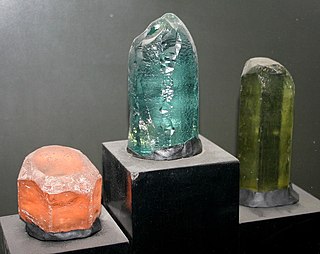
Beryl ( BERR-əl) is a mineral composed of beryllium aluminium silicate with the chemical formula Be3Al2Si6O18. Well-known varieties of beryl include emerald and aquamarine. Naturally occurring, hexagonal crystals of beryl can be up to several meters in size, but terminated crystals are relatively rare. Pure beryl is colorless, but it is frequently tinted by impurities; possible colors are green, blue, yellow, pink, and red (the rarest). It is an ore source of beryllium.

Corundum is a crystalline form of aluminium oxide typically containing traces of iron, titanium, vanadium and chromium. It is a rock-forming mineral. It is a naturally transparent material, but can have different colors depending on the presence of transition metal impurities in its crystalline structure. Corundum has two primary gem varieties: ruby and sapphire. Rubies are red due to the presence of chromium, and sapphires exhibit a range of colors depending on what transition metal is present. A rare type of sapphire, padparadscha sapphire, is pink-orange.

Titanite, or sphene (from the Greek sphenos (σφηνώ), meaning wedge), is a calcium titanium nesosilicate mineral, CaTiSiO5. Trace impurities of iron and aluminium are typically present. Also commonly present are rare earth metals including cerium and yttrium; calcium may be partly replaced by thorium.

Topaz is a silicate mineral of aluminium and fluorine with the chemical formula Al2SiO4(F,OH)2. It is used as a gemstone in jewelry and other adornments. Common topaz in its natural state is colorless, though trace element impurities can make it pale blue or golden brown to yellow orange. Topaz is often treated with heat or radiation to make it a deep blue, reddish-orange, pale green, pink, or purple.

Fluorite (also called fluorspar) is the mineral form of calcium fluoride, CaF2. It belongs to the halide minerals. It crystallizes in isometric cubic habit, although octahedral and more complex isometric forms are not uncommon.

Rhodochrosite is a manganese carbonate mineral with chemical composition MnCO3. In its pure form (rare), it is typically a rose-red colour, but it can also be shades of pink to pale brown. It streaks white, and its Mohs hardness varies between 3.5 and 4.5. Its specific gravity is between 3.45 and 3.6. It crystallizes in the trigonal system, and cleaves with rhombohedral carbonate cleavage in three directions. Crystal twinning often is present. It is often confused with the manganese silicate, rhodonite, but is distinctly softer. Rhodochrosite is formed by the oxidation of manganese ore, and is found in South Africa, China, and the Americas. It is officially listed as one of the National symbols of Argentina.

Benitoite is a rare blue barium titanium cyclosilicate, found in hydrothermally altered serpentinite. It forms in low temperature, high pressure environments typical of subduction zones at convergent plate boundaries. Benitoite fluoresces under short wave ultraviolet light, appearing bright blue to bluish white in color. The more rarely seen clear to white benitoite crystals fluoresce red under long-wave UV light.
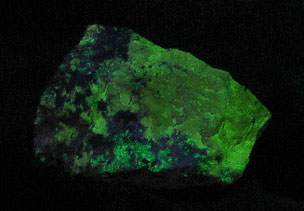
Esperite is a rare complex calcium lead zinc silicate (PbCa3Zn4(SiO4)4) related to beryllonite and trimerite that used to be called calcium larsenite. It was named in honor of Esper F. Larsen Jr. (1879–1961), petrologist of Harvard University.

Spessartine is a nesosilicate, manganese aluminium garnet species, Mn2+3Al2(SiO4)3. This mineral is sometimes mistakenly referred to as spessartite.

Grossular is a calcium-aluminium species of the garnet group of minerals. It has the chemical formula of Ca3Al2(SiO4)3 but the calcium may, in part, be replaced by ferrous iron and the aluminium by ferric iron. The name grossular is derived from the botanical name for the gooseberry, grossularia, in reference to the green garnet of this composition that is found in Siberia. Other shades include cinnamon brown (cinnamon stone variety), red, and yellow. Grossular is a gemstone.
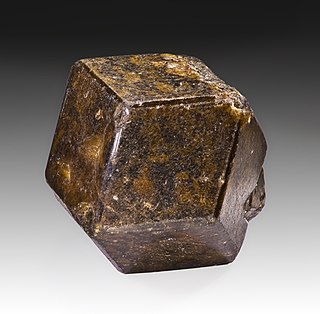
Andradite is a mineral species of the garnet group. It is a nesosilicate, with formula Ca3Fe2Si3O12.
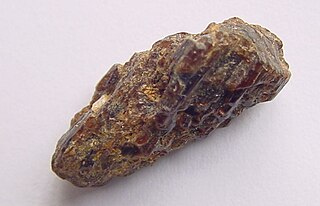
Painite is a very rare borate mineral. It was first found in Myanmar by British mineralogist and gem dealer Arthur C.D. Pain who misidentified it as ruby, until it was discovered as a new gemstone in the 1950s. When it was confirmed as a new mineral species, the mineral was named after him. Due to its rarity, painite can cost in the range of between US$50,000 to $60,000 per carat.

Nambulite is a lithium bearing manganese silicate mineral with the chemical formula (Li,Na)Mn4Si5O14(OH). It is named after the mineralogist, Matsuo Nambu (born 1917) of Tohoko University, Japan, who is known for his research in manganese minerals. The mineral was first discovered in the Funakozawa Mine of northeastern Japan, a metasedimentary manganese ore.
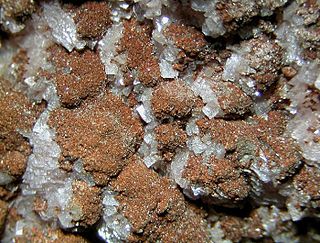
Caryopilite (synonymous with ectropite and ektropite) is a brown-colored mineral with formula (Mn2+,Mg)3Si2O5(OH)4. The mineral was discovered in 1889 from a mine in Sweden. It was named for the Greek words for walnut and felt in reference to its appearance.
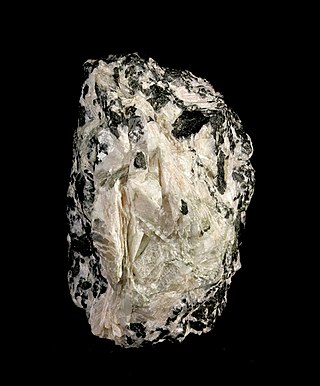
Baratovite is a very rare cyclosilicate mineral named after Rauf Baratovich Baratov from Tajikistan. It was discovered in 1974 at Dara-Pioz glacier, Tajikistan, and was approved by the International Mineralogical Association only a year later in 1975. The glacier gives home to 133 valid species, and is the type locality of 33 minerals, one of which is baratovite.
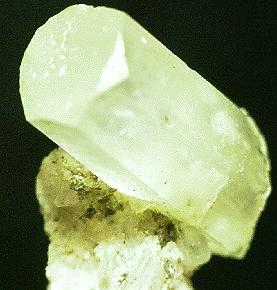
Milarite is a rare beryl. It is a member of the osumilite group. Crystals of this mineral typically come in green or yellow. The mineral gets name after Val Milar.
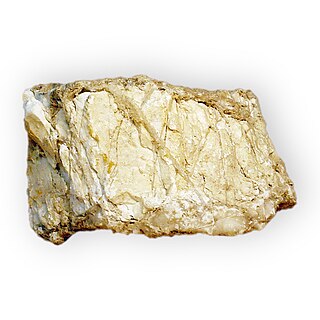
Priceite is a white borate mineral. The mineral has been found in places such as Chetco, Oregon, Death Valley, and northwestern Turkey. In 1862 small amounts of this mineral were mined from Chetco, Oregon.
Svabite is a arsenate mineral. The mineral is rare and is also a member of the Apatite group.
Tsilaisite is a manganese rich variety of elbaite tourmaline. It is also known as Tsilaizite. Tsilaisite is related Fluor-tsilaisite. The gem is named after the location it was first found.

Lizardite is a mineral from the serpentine subgroup with formula Mg3(Si2O5)(OH)4, and the most common type of mineral in the subgroup. It is also a member of the kaolinite-serpentine group.